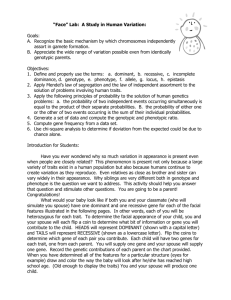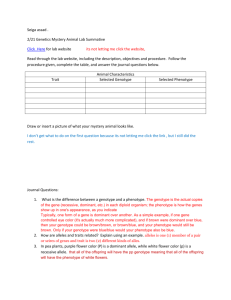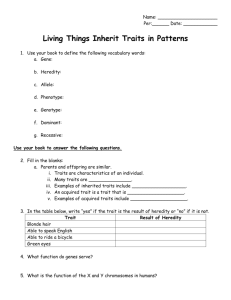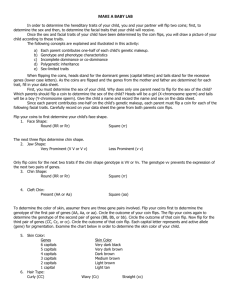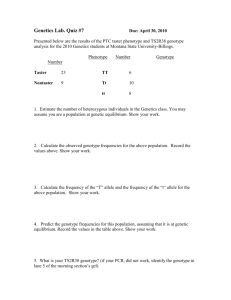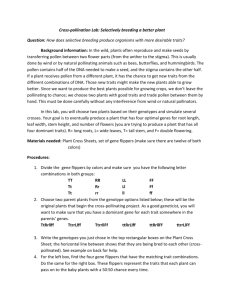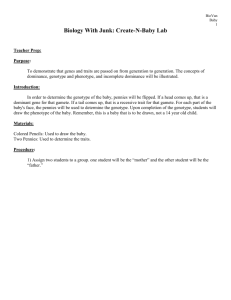*Face* Lab: A Study in Human Variation:
advertisement
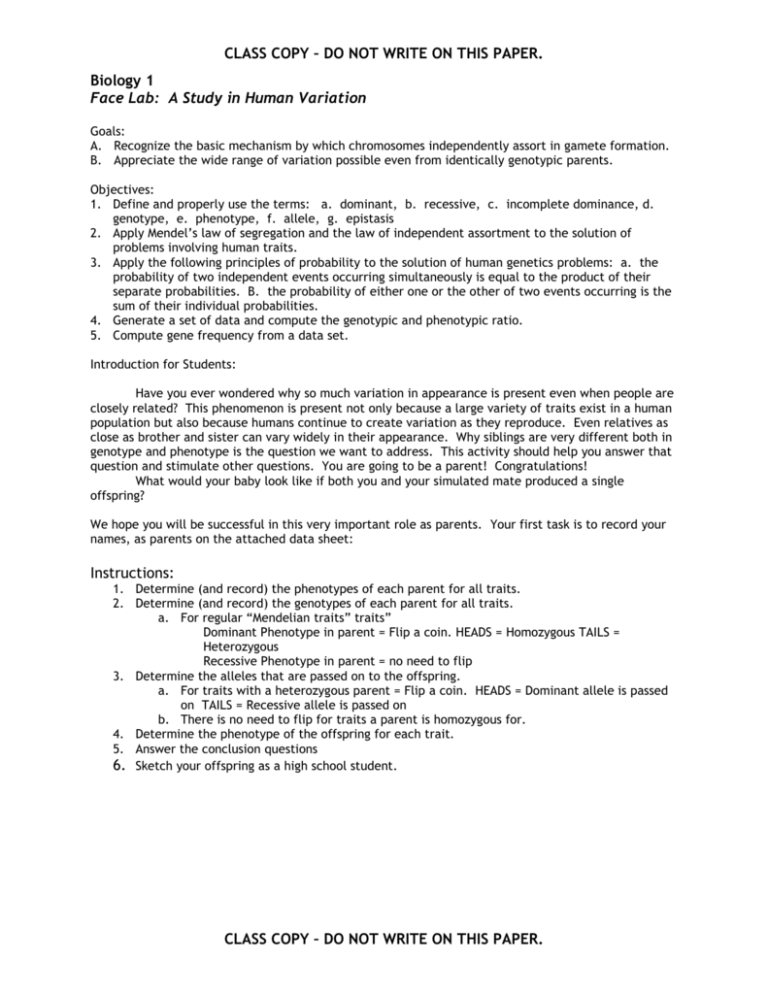
CLASS COPY – DO NOT WRITE ON THIS PAPER. Biology 1 Face Lab: A Study in Human Variation Goals: A. Recognize the basic mechanism by which chromosomes independently assort in gamete formation. B. Appreciate the wide range of variation possible even from identically genotypic parents. Objectives: 1. Define and properly use the terms: a. dominant, b. recessive, c. incomplete dominance, d. genotype, e. phenotype, f. allele, g. epistasis 2. Apply Mendel’s law of segregation and the law of independent assortment to the solution of problems involving human traits. 3. Apply the following principles of probability to the solution of human genetics problems: a. the probability of two independent events occurring simultaneously is equal to the product of their separate probabilities. B. the probability of either one or the other of two events occurring is the sum of their individual probabilities. 4. Generate a set of data and compute the genotypic and phenotypic ratio. 5. Compute gene frequency from a data set. Introduction for Students: Have you ever wondered why so much variation in appearance is present even when people are closely related? This phenomenon is present not only because a large variety of traits exist in a human population but also because humans continue to create variation as they reproduce. Even relatives as close as brother and sister can vary widely in their appearance. Why siblings are very different both in genotype and phenotype is the question we want to address. This activity should help you answer that question and stimulate other questions. You are going to be a parent! Congratulations! What would your baby look like if both you and your simulated mate produced a single offspring? We hope you will be successful in this very important role as parents. Your first task is to record your names, as parents on the attached data sheet: Instructions: 1. Determine (and record) the phenotypes of each parent for all traits. 2. Determine (and record) the genotypes of each parent for all traits. a. For regular “Mendelian traits” traits” Dominant Phenotype in parent = Flip a coin. HEADS = Homozygous TAILS = Heterozygous Recessive Phenotype in parent = no need to flip 3. Determine the alleles that are passed on to the offspring. a. For traits with a heterozygous parent = Flip a coin. HEADS = Dominant allele is passed on TAILS = Recessive allele is passed on b. There is no need to flip for traits a parent is homozygous for. 4. Determine the phenotype of the offspring for each trait. 5. Answer the conclusion questions 6. Sketch your offspring as a high school student. CLASS COPY – DO NOT WRITE ON THIS PAPER. CLASS COPY – DO NOT WRITE ON THIS PAPER. Traits: 1. First we should determine the sex of your child. Which parent should flip a coin to determine the sex of the child? Heads will be a boy (Y-bearing sperm) and tails will be a girl (x-bearing sperm). Give your child a name and record the name on your data sheet. 2. Face Shape: Round (RR, Rr) Square (rr) 3. Chin a. Chin Shape: Next three flips Very prominent (BB, Bb) Less prominent (bb) b. Chin Shape: ONLY outline this trait if chin shape genotype from #2 is VV or Vv. (the genotype vv prevents the expression of the next two pairs of genes) Round (RR, Rr) Square (rr) c. Cleft Chin: Present (AA, Aa) Absent (aa) CLASS COPY – DO NOT WRITE ON THIS PAPER. CLASS COPY – DO NOT WRITE ON THIS PAPER. 4. Skin Color: To determine the color of skin, assume there are three gene pairs involved. Use the chart below to determine your skin color. Each capital letter represents an active allele for pigmentation. 6 Capitals—very dark black – start with parent genotype: AA BB CC 5 Capitals—very dark brown – start with parent genotype: AA BB Cc 4 Capitals—dark brown – start with parent genotype: AA Bb Cc 3 Capitals—medium brown – start with parent genotype: Aa Bb Cc 2 Capitals—light brown – start with parent genotype: Aa Bb cc 1 Capital—light tan – start with parent genotype: Aa bb cc 0 Capitals—white – start with parent genotype: aa bb cc 5. Hair Color – There are two pigment molecules that can be produced and deposited in your hair. a. (Eumelanin – brown)—Gene #1 locus Heavy melanin - E E Medium melanin - E e Light melanin - e e b. (Pheomelanin - red)—Gene #2 locus RR =some red rr= no red, and Rr = some red. Combine genotypes from 5a and 5b using the chart below to determine hair color: Gene # 2 Gene # 1 No Red Some Red Heavy Red rr Rr RR ee Light Blonde Strawberry Bonde Bright Red Ee Light Brown Brown Dark Red EE Black Dark Brown Auburn 6. Hair Type: Curly (CC) Wavy (Cc) Straight (cc) CLASS COPY – DO NOT WRITE ON THIS PAPER. CLASS COPY – DO NOT WRITE ON THIS PAPER. 7. Widow’s Peak: The hair-line comes to a point in the center of the forehead. Present (WW, Ww) Absent (ww) 8. Color of Eyebrows: Very Dark (HH) Medium Dark (Hh) 9. Eyebrow Thickness: Bushy (BB, Bb) Fine (bb) 10. Eyebrow Placement: Not connected; (NN, Nn) Connected (nn) Light (hh) 11.Eye Color: Darker eyes are produced in the presence of more active alleles. In this situation, the large letters (A or B) represent alleles which are active depositing dark pigment. Small letters (a and b) represent alleles which deposit little pigment. To determine the color of the eyes, assume there are two gene pairs involved, one which codes for depositing pigment in the front of the iris and one which codes for depositing pigment in the back of the iris. Use the chart to match your phenotype to a genotype. If you have an eye color that is produced by multiple genotypes, you can choose your genotype from the possibilities at random. 1 AABB AABb AaBB AaBb No they don’t 2 Dark Brown Brown Brown Brown My eyes change color depending on what I wear 1 AAbb aaBB Aabb aaBb aabb CLASS COPY – DO NOT WRITE ON THIS PAPER. 2 Hazel Dark Blue Green Light Blue Pale Blue CLASS COPY – DO NOT WRITE ON THIS PAPER. 12. Eyes: Distance apart: Close together: (EE) Average (Ee) Far Apart (ee) 13. Eyes: Size Large (EE) Medium (Ee) Small (ee) 14. Eyes: Shape Almond (AA, Aa) Round (aa) 15. Eyes: Slantedness Horizontal (HH, Hh) Upward Slant (hh) 16. Eyelashes: Long (LL, Ll) Short (ll) 17. Mouth: Size Long (MM) 18. Lips: Thick (LL, Ll) Average (Mm) Short (mm) Thin (ll) CLASS COPY – DO NOT WRITE ON THIS PAPER. CLASS COPY – DO NOT WRITE ON THIS PAPER. 19. Protruding Lip: Very Protruding (HH) Slightly (Hh) 20. Dimples: Present (DD, Dd) 21. Nose Size: Big (NN) Absent (hh) Absent (dd) Medium (Nn) 22. Nose Shape: Rounded (RR, Rr) Pointed (rr) 23. Nostril Shape: Rounded (RR, Rr) Pointed (rr) Small (nn) CLASS COPY – DO NOT WRITE ON THIS PAPER. CLASS COPY – DO NOT WRITE ON THIS PAPER. 24. Earlobe attachment: Free (FF, Ff) Attached (ff) 25. Darwin’s Earpoint: Present (DD, Dd) Absent (dd) 26. Ear pits Present (PP, Pp) Absent (pp) 27. Hairy ears: (Sex-limited to males) Absent (X-X-, X-YN ) Present (X-Yn) 28. Freckles on cheeks: Present (FF, Ff) Absent (ff) CLASS COPY – DO NOT WRITE ON THIS PAPER. CLASS COPY – DO NOT WRITE ON THIS PAPER. 29. Freckles on Forehead: Present (FF, Ff) Absent (ff) *Most of the traits in this activity were created to illustrate how human heredity works in a simplified model and to reinforce basic genetics principles. In actuality, inherited characteristics of the face are much more complicated than this activity illustrates. Most of these facial characteristics are determined by many genes working together in a way geneticists do not yet understand. CLASS COPY – DO NOT WRITE ON THIS PAPER.

